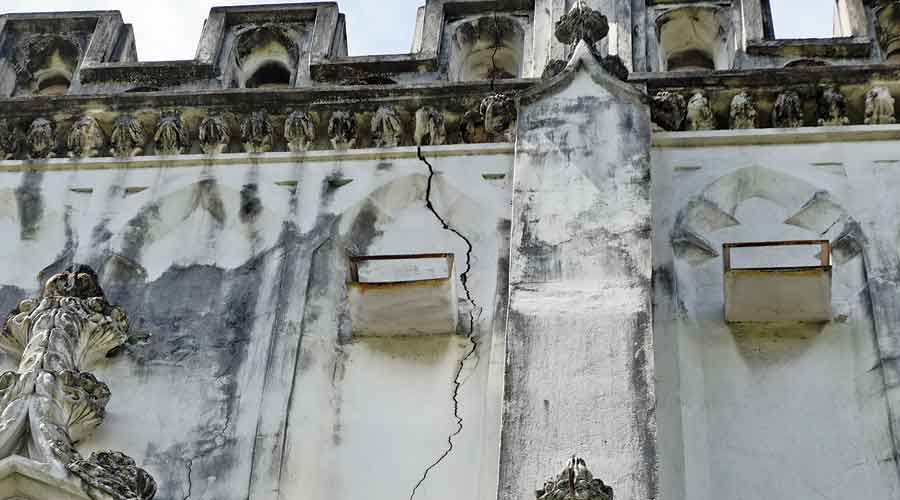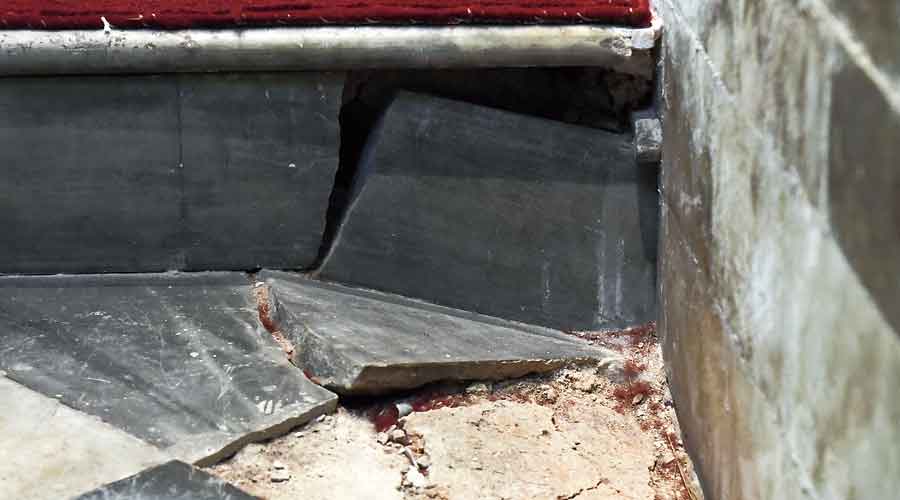Two earthquakes, a cyclone and the ravages of time have pushed Calcutta’s St Paul’s Cathedral to a stage where only structural restoration can protect it from future tremors, a restoration architect has said.
The cathedral has had a long history of damage from earthquakes starting from 1897. In the 1934 earthquake, it lost its steeple tower. It was rebuilt to a revised design, along the lines of the central Bell Harry tower of Canterbury Cathedral.
Built on marshy land, 180 years ago, the cathedral faced foundation issues from the beginning. Subsequent earthquakes have ravaged the building repeatedly. “Structural restoration has become very important at present against future earthquakes,” architect Partharanjan Das, who is leading the restoration effort at St Paul’s Cathedral, said.

A crack in a wall with a fresco Sanat Kr Sinha
In recent years, the Nepal and the Sikkim earthquakes have wrought considerable damage, which have been exacerbated by Cyclone Amphan. Large cracks have appeared in the walls and the altar table has been sinking rapidly in the past few years. Existing cracks have increased and become more pronounced after the cyclone, Das said.
Besides the subsidence of the altar table and the wide cracks and fissures on the eastern wall, the turrets of the cathedral that give the cathedral its distinctive look, have been heavily damaged with the inbuilt iron framework exposed and decaying. “These turrets can come crashing down any day,” the architect said.
“The cathedral has had foundation issues right from the beginning. We got to know that Major William Nairn Forbes, the chief engineer of the church, faced a major dilemma halfway through the foundation of the church,” Himadri Guha, who is part of the restoration team, said.
He has gone through church documents in England and India. “Forbes had two issues. The foundation was sinking because of bad soil and the then bishop had enforced an economy stricture. To counter, Forbes chose a design where the weight of the roof would not be more than one-third of an ordinary one. Forbes felt that the light roof would stop the subsidence and he could conform to the bishop’s economy stricture. But he did record for posterity that there would be no lateral pressure. The absence of lateral stiffness is the main cause of fatal weakness of the cathedral from earthquakes.”

A crack on an outer wall of the cathedral Sanat Kr Sinha
The restoration team has recently concluded its survey and stressed the seriousness of the cracks and settlements. “The original weakness of the structural arrangement of the edifice still persists. The cathedral was affected by the three large earthquakes that happened near Calcutta in the past 125 years…. The east wall is seriously damaged,” Das said.
“The earthquake risk in Calcutta has recently been increased in the National Building Code, the standard for constructions in India. In such a scenario, we feel the edifice should be retrofitted to counter earthquake risks to avoid major failure in future.”
Repairs have started as a temporary measure. But the apparent facelift will not reduce the earthquake risk and should be properly treated in future, Das said.
He has advised that a world class consultant with prior experience in retrofitting a similar heritage church be engaged and the design be reviewed by a university or institute before finalising a definite retrofitting plan. “The retrofitting might even require extensive interventions like installing steel structure within the masonry buttresses,” Das said.
Reverend Paritosh Canning, the bishop of Calcutta, CNI, said: “We are eager to get the cathedral restored… we appeal to everyone to come forward and help.”
Noted for its Gothic architecture that was suited to meet the climate of India, St Paul’s Cathedral is dedicated to Paul the apostle and is the seat of the Diocese of Calcutta.
The cornerstone was laid in 1839 and the building completed in 1847. It is the largest church in the city and the first Anglican cathedral in Asia. It was the first new cathedral in the overseas territory of the British empire.

Broken tiles and the damaged floor inside Sanat Kr Sinha
Apart from that of Bishop Daniel Wilson, the founder of the cathedral, the other notable burial in the church is that of John Paxton Norman, an acting chief justice who was assassinated on the steps of the Calcutta Town Hall in 1871.
The cathedral is across the Bishop’s House at 51 Chowringhee Road, in a direct line of sight from the Victorial Memorial.
The cathedral was built to replace St John’s Church, which had become too small for Calcutta’s growing European community; by 1810 there were 4,000 British men and 300 British women in Bengal.










